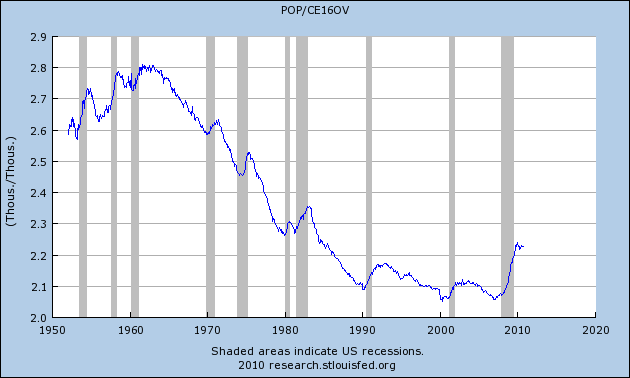The perennial debate about the health of the U.S. Economy has acquired a new catchphrase, “Secular Stagnation”, which I spotted at Beat the Press responding to an article in the New York Times. Dean Baker apparently agrees with Larry Summers that secular stagnation is real and is not just a consequence of the Great Recession of 2008-2009.
I think a very good case can be made that the secular stagnation clearly began sooner (and Summers evidently would agree albeit for different reasons). Ex debt growth, the U.S. economy’s growth rate has been abysmal for decades, a tale told in many ways including stagnating real median income, real median household income levels, and rising per-capita private-sector debt burdens. The stagnation appears to date back to at least the Clinton administration, in fact. The economic boom during the Clinton administration was fueled by unsustainable financial practices. The Administration’s economic team included Summers and all the other Rubinites at Treasury and so on, and was complicit in both the creation of both the huge stock market bubble and the evisceration of Glass-Steagall and other sound, but restrictive financial regulations (CFMA comes to mind as well…). The deficit of financial prudence created a tremendous boom while it lasted, but left George W. Bush’s team facing a bust of historical proportions.
Unfortunately the deficit of financial prudence has persisted longer than the boom did, and the Bush team’s policy responses from 2000-2004 created their own dire aftermath in 2008. Feeling snarky, I might even say that the “prudence deficit” persists even today, among folks who claim that there isn’t a debt crisis, when the glut of credit creation (which leads to the low interest rates which these folks believe are okay) IS the problem and WILL BE the source of the next crisis, already brewing. This is not to say that within the credit bubble, there wasn’t also a mass financial mania as illustrated by the consequences of Lehman’s demise. Just that we are not done with all the adverse consequences of the credit bubble, and there is likely to be another great crisis as soon as the Obama Administration is unable or unwilling to kick the can any further.
The secular stagnation issue is aggravated by the reality that neither individuals nor economies thrive when total debt burdens (private, corporate and public) are three or more times the annual production rate… although such conditions are ideal for the rentiers collecting the interest and other rents without needing to be productive – at least until the low interest rates run into high default rates and force rentiers back to work! But the eventual deleveraging (reduction of debt) punishes everyone, because when growth in credit slows or reverses, it no longer fuels growth in spending or production the way that it previously did.
The best we can hope for at this point is a “beautiful deleveraging”, consisting (per Ray Dalio at Bridgewater) of a combination of debt restructuring, austerity, money-printing and other transfers of wealth from rentiers and savers to debtors and wasters. Where “beauty” is simply that the deflationary side (restructuring and austerity) are balanced by the inflationary money printing. (Dalio did not mention in the link that one may also pursue policies to stimulate organic (debt free) growth in production, which also brings down the economic burden of high debt levels.)
It appears that the writers of the Federal Reserve Reform Act of 1997 were wiser than most of us nowadays, for they mandated this (emphasis added):
The Board of Governors of the Federal Reserve System and the Federal Open Market Committee shall maintain long run growth of the monetary and credit aggregates commensurate with the economy's long run potential to increase production, so as to promote effectively the goals of maximum employment, stable prices, and moderate long-term interest rates.
Today, everyone who watches the Fed remembers the part about “maximum employment and stable prices” (though forgetting both “moderate long-term interest rates” and that inflation at 2%/year is not truly “stable prices”), but we often forget that the real goal is, wisely, to prevent long run credit growth in excess of the economy’s long run potential to increase production. Because excess credit growth over the long run becomes a credit bubble, credit bubbles are not sustainable, and the consequences take decades to resolve. Which why we have secular stagnation and the best we can hope for is a “beautiful” deleveraging.
Far more beautiful would the world be, had the Federal Reserve and the Clinton, Bush and Obama administrations’ economics teams (including the regulators and the law enforcers as well as the policymakers) done more to help keep the ugliness of high debt out of the economy in the first place!


